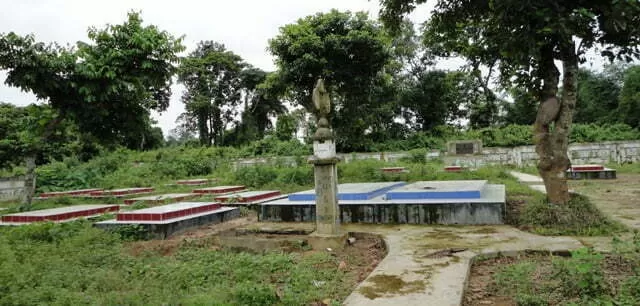ARUP SAIKIA chronicles here the valiant soldiers of 34 native infantry who sacrificed their lives fighting against the Britishers at Malegarh fort near Latu in Karimganj during the Sepoy Mutiny of 1857.
When the entire nation paid homage to the heroes of the Indian Independence on the 68th Independence Day, bravehearts of Sepoy Mutiny in Assam are still waiting to get their due share of recognition.
The Assam government has not yet initiated any concrete move to highlight the contribution of Indian sepoys who fought valiantly at Malegarh fort near Latu in Karimganj district against the British.
Highlighting the facts of the historic battle holds significances as Hindu and Muslim sepoys fought shoulder to shoulder in that encounter to give the Indian Sepoys one of their first victories against the mighty British force.
Especially at a time when there is an urgent need to restore communal harmony in the violent hit BTAD areas this infact was a chance missed by many in ameliorating the bitterness developed amongst people belonging to different religions.
Malegarh, a small hillock situated on the bank of river Longai along the Indo-Bangladesh border is the very place where 26 brave hearts of the 34 native infantry who sacrificed their lives for our better tomorrow of other but unfortunately it has remained unheard to many.
Locals are observing the December 18 every year as martyr’s day to commemorate the soldiers of the 34 native infantry who were killed in a fierce encounter with Sylhet Light Infantry of British army during the Sepoy Mutiny of 1857 on that very same date in the area.
Following repeated pleas from local organizations to give special honour to the martyrs, the state government till date has only initiated measures to hoist the national flag in the Malegarh fort on Independence Day to commemorate the martyrs’.
Though the state government has initiated steps to develop the burial place of 26 India sepoys and six soldiers of colonial force including their leader Major Byng as a tourist spot but still it remains unheard for people beyond Barak valley due to lack of publicity on the part of the state
government.
Historical details available with few senior citizens of the Latu area says that the rebel sepoys were successfully led by Rizbul Khan, Sher Khan and Samsher Khan and Ayodhya Prasad Singh and most of them were from Orrisa, Bihar, Uttar Pradesh and other parts of northern India.
Most important part of the battle was that there was a great sense of unity among the Muslims and Hindu sepoys in the infantry which resulted in their success. History has evidence that most of the anti-British uprising in the country was suppressed successfully by the colonial force due to lack of unity among Muslims and Hindus fighting against them.
The Assam tourism department has constructed a war memorial at the site in 2007, but it has not been maintained well by the department.
Patkai Trekkers, an NGO working for the conservation of the war memorial at Malegarh, told this correspondent that the department had constructed only 18 tombs whereas 31 graves had been identified by the locals of the area in the late sixties. Out of the 31 graves, five belongs to the Sylhet Light Infantry while 26 are of the Indian sepoys. The commandant of the Sylhet
Light Infantry, Major Byng, was buried at Badarpur in Karimganj district.
Muzib Rehman, Barak valley coordinator of Patkai Trekkers said they have submitted memorandums to chief minister Tarun Gogoi to include a chapter of Malegarh battle in school curriculum to make school students aware of the historic battle.
“We want national heritage site status for Malegarh burial ground and inclusion of its reference in school curriculum,’ Rehman said.
“Though Border Security Force (BSF) has taken some initiative for the preservation of Malegarh but without government participation the goal will not be achieved,” Rehman said.
The State may soon also lose a significant treasure of the Sepoy Mutiny era if the Government do not shows its willingness to preserve the war remains of the Malegarh fort.
The war remains of the Sepoy Mutiny era which includes one antique pistol, few swords and some bullets are now in the possession of the family of Abdul Mukib Choudhury, a senior citizen of the area.
Late Choudhury along with the locals of the Latu area discovered the burial ground of the soldiers in the fort.
But ironically repeated plea of Choudhury when he was alive to the Karimganj district administration for perseveration of the war remains had fallen on deaf ear.
“Choudhury is no more now and we are afraid how well his family will look after the war remains. We have also come to know that two cannon balls which were in possession of Choudhury has already gone missing,” Rehman said.







